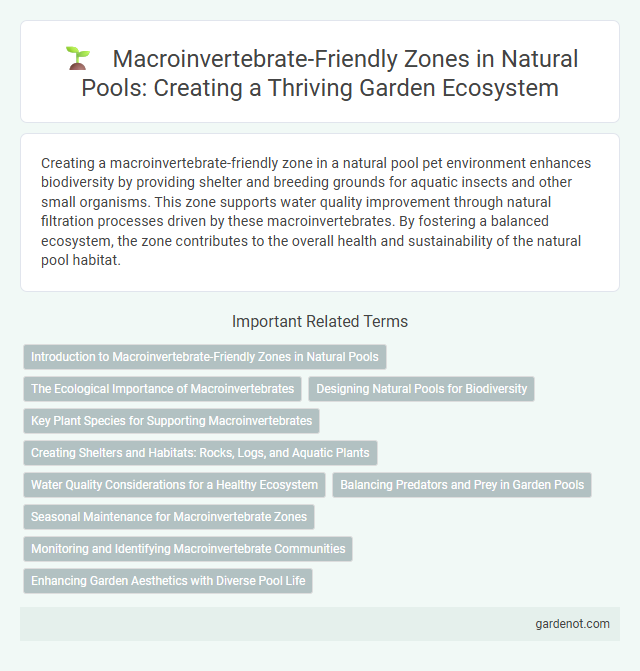Creating a macroinvertebrate-friendly zone in a natural pool pet environment enhances biodiversity by providing shelter and breeding grounds for aquatic insects and other small organisms. This zone supports water quality improvement through natural filtration processes driven by these macroinvertebrates. By fostering a balanced ecosystem, the zone contributes to the overall health and sustainability of the natural pool habitat.
Introduction to Macroinvertebrate-Friendly Zones in Natural Pools
Macroinvertebrate-friendly zones in natural pools are essential habitats designed to support aquatic insects, crustaceans, and other small organisms critical for ecosystem balance. These zones feature diverse plant species and varying water depths to provide shelter, breeding grounds, and food sources. Enhancing biodiversity through these zones improves water quality via natural filtration and promotes a resilient aquatic food web.
The Ecological Importance of Macroinvertebrates
Macroinvertebrates play a critical role in natural pool ecosystems by serving as bioindicators of water quality and contributing to nutrient cycling and organic matter decomposition. These organisms support biodiversity by providing food for fish and amphibians, maintaining ecological balance within the macroinvertebrate-friendly zone. Protecting this habitat enhances natural filtration processes and promotes a healthy, self-sustaining aquatic environment.
Designing Natural Pools for Biodiversity
Creating a macroinvertebrate-friendly zone in natural pools enhances biodiversity by providing suitable habitats such as shallow, vegetated areas rich in organic matter. These zones support diverse species including insects, crustaceans, and mollusks vital for ecosystem balance and water quality. Designing natural pools with varied substrates and gentle water flow encourages colonization by macroinvertebrates, fostering ecological resilience.
Key Plant Species for Supporting Macroinvertebrates
Key plant species such as water lilies (Nymphaea spp.), submerged plants like pondweeds (Potamogeton spp.), and emergent vegetation including rushes (Juncus spp.) create essential habitats that support diverse macroinvertebrate populations in natural pools. These plants provide shelter, breeding grounds, and food sources critical for macroinvertebrate development and survival. Maintaining a balanced mix of these species enhances biodiversity and promotes ecosystem stability within macroinvertebrate-friendly zones.
Creating Shelters and Habitats: Rocks, Logs, and Aquatic Plants
Creating shelters and habitats in a macroinvertebrate-friendly zone involves strategically placing rocks, logs, and aquatic plants to mimic natural environments. These structures provide essential hiding spots, breeding grounds, and feeding areas for diverse macroinvertebrate species, enhancing biodiversity within the natural pool. Incorporating varied textures and depths encourages habitat complexity, supporting ecological balance and water quality improvement.
Water Quality Considerations for a Healthy Ecosystem
Creating a macroinvertebrate-friendly zone in a natural pool involves maintaining optimal water quality parameters such as balanced pH levels between 6.5 and 8.0, low nutrient concentrations to prevent algal blooms, and adequate dissolved oxygen above 5 mg/L. Filtering systems that reduce pollutants and sediments while preserving organic matter provide essential habitat for macroinvertebrates, supporting biodiversity and biological filtration processes. Regular monitoring of ammonia, nitrate, and phosphate levels ensures a stable ecosystem that promotes healthy macroinvertebrate populations vital for natural pool water purification.
Balancing Predators and Prey in Garden Pools
Creating a macroinvertebrate-friendly zone in natural garden pools supports biodiversity by establishing balanced predator-prey relationships crucial for ecosystem health. Planting native aquatic vegetation provides habitat and shelter, encouraging beneficial insects like dragonfly larvae that control mosquito populations without harming other invertebrates. Maintaining diverse microhabitats, such as submerged logs and gravel beds, enhances habitat complexity, promoting stable populations and natural biological control.
Seasonal Maintenance for Macroinvertebrate Zones
Seasonal maintenance of macroinvertebrate-friendly zones in natural pools involves regular monitoring and careful removal of debris to preserve habitat quality and biodiversity. Managing vegetation growth through selective pruning helps maintain optimal water flow and oxygen levels, crucial for sustaining macroinvertebrate populations. Scheduled assessments during spring and autumn ensure that detritus accumulation does not disrupt the ecological balance essential for macroinvertebrate survival.
Monitoring and Identifying Macroinvertebrate Communities
Monitoring and identifying macroinvertebrate communities in a natural pool's macroinvertebrate-friendly zone involves regular sampling and taxonomic analysis to assess biodiversity and ecological health. Effective identification utilizes standardized methods such as kick sampling and microscopy to detect indicator species sensitive to water quality changes. Data collected supports adaptive management strategies to maintain habitat conditions favorable for diverse macroinvertebrate populations.
Enhancing Garden Aesthetics with Diverse Pool Life
Creating a macroinvertebrate-friendly zone in a natural pool boosts garden aesthetics by introducing diverse aquatic life such as dragonfly larvae, water beetles, and snails. These organisms contribute to a balanced ecosystem, improving water clarity while adding vibrant movement and texture. Incorporating native plants around the pool's edges provides habitat and food sources, further enhancing biodiversity and visual appeal.
Macroinvertebrate-friendly zone Infographic

 gardenot.com
gardenot.com